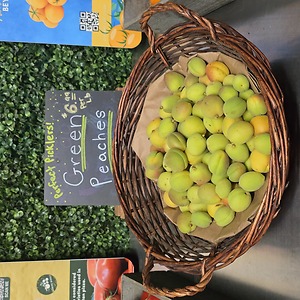


Green Peaches
Estimated Inventory, lb : 0
Description/Taste
Green peaches are the immature, not-yet-ripe fruit of the peach tree. They are small and oval-shaped, measuring about 7 centimeters long and 3 centimeters around. Their skin is primarily light green with occasional small, light brown patches. Green peaches have a fuzzy exterior that gives the fruit a subtle silver-grey tone. Its flesh transitions from bright green to a lighter green-white tone as it inches closer to the fruit pit. The flesh has a hard, firm texture that’s significantly less juicy than ripe peaches. Conversely, the pit is softer than that of its ripe counterpart. Though its fragrance is mild, Green peaches may have a faintly sweet and floral scent. They have a tart-sour taste that lacks the sweetness of ripe peaches because the sugar levels increase as the fruit matures.
Seasons/Availability
Green peaches are available in the spring and early summer.
Current Facts
Green peaches are botanically classified as Prunus persica and belong to the Rosaceae family. These peaches are green because they’re picked when young and underripe. The green tone is also caused by its heightened chlorophyll content, an element that breaks down once the fruit becomes ripe. Once ripe, the chlorophyll is replaced with anthocyanins and carotenoids, natural pigments that give peaches their yellow, orange, and red tones. Unlike other varieties of underripe fruit, Green peaches aren’t poisonous. They are just more acidic than their ripe counterparts, something that doesn’t make them inherently toxic but may cause indigestion or discomfort for people with sensitive stomachs.
Nutritional Value
Green peaches provide the same nutrients as ripe peaches, just in slightly different quantities. They tend to have more fiber than ripe peaches, making them potentially better for aiding digestion. Green peaches are rich in vitamins C and A, which may help with cellular growth, vision, and skin and immune health. They contain potassium and magnesium that can help regulate blood pressure, muscle and nerve function, and heart health. The antioxidants in Green peaches may boost collagen production, UV protection, and anti-aging potential. Green peaches have been used in traditional Chinese medicine for their therapeutic benefits. They were thought to have cooling properties that may alleviate the symptoms of heat-induced ailments, fever, and inflammation. Green peach extract has been used for respiratory problems and skin ailments.
Applications
Green peaches can be consumed raw, cooked, or pickled, though the peach pit should not be consumed. They can be eaten raw as a stand-alone snack, used in salsa, blended into a smoothie or cocktail, or tossed into a fruit salad to add a crisp, tangy flavor. Pickling Green peaches is done in the Middle East and can be accomplished using vinegar-based brine, mustard seeds, chili flakes, fennel, and jalapeños. Once pickled, they can be used on a charcuterie plate, in a salad, or in place of olives in a martini. Poaching Green peaches in a mixture of water, sugar, spices, and fruit juices can enhance their flavor and make them taste less sour. Green peaches can be cooked into pies, cobblers, and tarts. They can be used for making preserves like jam, jelly, and chutney. In Japan, they are found in the center of pastries and served with mochi. The tart flavor of Green peaches pairs well with blue cheese, garlic, scallions, lemon, olive oil, celery, and salad greens. Before consuming Green peaches, prick their firm flesh with a toothpick or knife so they can better absorb flavors. When stored at room temperature for a few days, they will ripen into a more flavorful and juicy peach.
Ethnic/Cultural Info
In ancient China, Green peaches were often associated with vitality and longevity. They were served during Lunar New Year celebrations to symbolize good fortune. In the Southern United States, where peaches are a valued fruit for desserts, Green peaches are often made into preserves and used as a spread for toast and savory meats. The origins of consuming underripe fruit can be traced back to more agrarian cultures. In these communities, underprivileged children in need of sustenance would steal underripe fruit from farmers. They resorted to this practice because they knew that farmers were more vigilant against theft when their fruit was at its ripest. Knowing they had to act quickly, children would harvest the fruit before the farmers noticed anything was missing.
Geography/History
Peaches are native to China and grow best in temperate climates with full sun exposure. Though they may be found in wild environments like thickets, roadsides, and disturbed habitats, Green peaches are more likely to be cultivated on commercial farms, orchards, and home gardens. This is particularly true because harvesting them while green requires careful monitoring of their ripening process. Peaches spread worldwide when traded from China to India, Western Asia, and Italy, the latter of which is one of the biggest producers of peaches today. Green peaches have become more popular with chefs and food enthusiasts due to their unique and versatile flavor that bodes well for cocktails and gourmet salads. These days, Green peaches can be found at farmer’s markets, specialty stores, and home gardens.
Recipe Ideas
Recipes that include Green Peaches. One
| Give Recipe |
|
Pickled Unripe Peaches |
| No Recipes |
|
Green Peach Salad with Feta |











